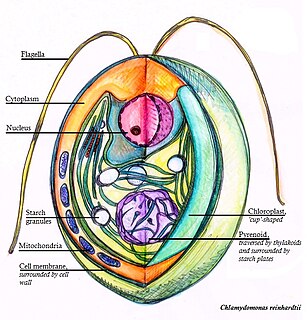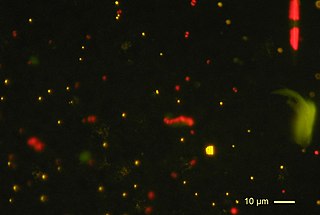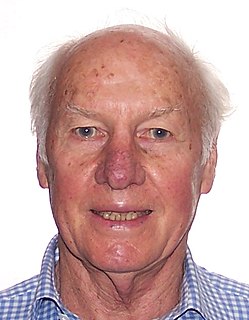
Chloroplasts are organelles that conduct photosynthesis, where the photosynthetic pigment chlorophyll captures the energy from sunlight, converts it, and stores it in the energy-storage molecules ATP and NADPH while freeing oxygen from water in plant and algal cells. They then use the ATP and NADPH to make organic molecules from carbon dioxide in a process known as the Calvin cycle. Chloroplasts carry out a number of other functions, including fatty acid synthesis, much amino acid synthesis, and the immune response in plants. The number of chloroplasts per cell varies from one, in unicellular algae, up to 100 in plants like Arabidopsis and wheat.

Cyanobacteria, also known as Cyanophyta, are a phylum consisting of free-living bacteria and the endosymbiotic plastids, a sister group to Gloeomargarita, that are present in some eukaryotes. They commonly obtain their energy through oxygenic photosynthesis. The oxygen gas in the atmosphere of earth is produced by cyanobacteria of this phylum, either as free-living bacteria or as the endosymbiotic plastids. The name cyanobacteria comes from the color of the bacteria. Cyanobacteria, which are prokaryotes, are also called "blue-green algae", though some modern botanists restrict the term algae to eukaryotes. Cyanobacteria appear to have originated in freshwater or a terrestrial environment.

The plastid is a membrane-bound organelle found in the cells of plants, algae, and some other eukaryotic organisms. They are considered endosymbiotic Cyanobacteria, related to the Gloeomargarita. Plastids were discovered and named by Ernst Haeckel, but A. F. W. Schimper was the first to provide a clear definition. Plastids are the site of manufacture and storage of important chemical compounds used by the cells of autotrophic eukaryotes. They often contain pigments used in photosynthesis, and the types of pigments in a plastid determine the cell's color. They have a common evolutionary origin and possess a double-stranded DNA molecule that is circular, like that of prokaryotic cells.

Chlamydomonas is a genus of green algae consisting of about 325 species all unicellular flagellates, found in stagnant water and on damp soil, in freshwater, seawater, and even in snow as "snow algae". Chlamydomonas is used as a model organism for molecular biology, especially studies of flagellar motility and chloroplast dynamics, biogenesis, and genetics. One of the many striking features of Chlamydomonas is that it contains ion channels (channelrhodopsins) that are directly activated by light. Some regulatory systems of Chlamydomonas are more complex than their homologs in Gymnosperms, with evolutionarily related regulatory proteins being larger and containing additional domains.

The green algae are a large, informal grouping of algae consisting of the Chlorophyta and Charophyta/Streptophyta, which are now placed in separate divisions, as well as the potentially more basal Mesostigmatophyceae, Chlorokybophyceae and Spirotaenia.

Pyrenoids are sub-cellular micro-compartments found in chloroplasts of many algae, and in a single group of land plants, the hornworts. Pyrenoids are associated with the operation of a carbon-concentrating mechanism (CCM). Their main function is to act as centres of carbon dioxide (CO2) fixation, by generating and maintaining a CO2 rich environment around the photosynthetic enzyme ribulose-1,5-bisphosphate carboxylase/oxygenase (RuBisCO). Pyrenoids therefore seem to have a role analogous to that of carboxysomes in cyanobacteria.

Chlamydomonas reinhardtii is a single-cell green alga about 10 micrometres in diameter that swims with two flagella. It has a cell wall made of hydroxyproline-rich glycoproteins, a large cup-shaped chloroplast, a large pyrenoid, and an eyespot that senses light.

The Archaeplastida are a major group of autotrophic eukaryotes, comprising the red algae (Rhodophyta), the green algae, and the land plants, together with a small group of freshwater unicellular algae called glaucophytes. Unlike red and green algae, glaucophytes have never been involved in secondary endosymbiosis events. All of these organisms have chloroplasts that are surrounded by two membranes, suggesting that they were acquired directly from endosymbiotic cyanobacteria. In all other groups besides the amoeboid Paulinella chromatophora, the chloroplasts are surrounded by three or four membranes, suggesting they were acquired secondarily from red or green algae.

Biohydrogen is H2 that is produced biologically. Interest is high in this technology because H2 is a clean fuel and can be readily produced from certain kinds of biomass.

Photosynthetic picoplankton or picophytoplankton is the fraction of the phytoplankton performing photosynthesis composed by cells between 0.2 and 2 µm (picoplankton). It is especially important in the central oligotrophic regions of the world oceans that have very low concentration of nutrients.
Anastasios Melis is an American biologist at the University of California, Berkeley who elucidated the possibility of creating hydrogen from algae. He is currently Professor of Plant & Microbial Biology in the institution and Editor-in-Chief of the Planta journal.

Plant evolution is the subset of evolutionary phenomena that concern plants. Evolutionary phenomena are characteristics of populations that are described by averages, medians, distributions, and other statistical methods. This distinguishes plant evolution from plant development, a branch of developmental biology which concerns the changes that individuals go through in their lives. The study of plant evolution attempts to explain how the present diversity of plants arose over geologic time. It includes the study of genetic change and the consequent variation that often results in speciation, one of the most important types of radiation into taxonomic groups called clades. A description of radiation is called a phylogeny and is often represented by type of diagram called a phylogenetic tree.
Prochloron is a unicellular oxygenic photosynthetic prokaryote commonly found as an extracellular symbiont on coral reefs, particularly in didemnid ascidians. Part of the phylum cyanobacteria, it was theorized that Prochloron is a predecessor of the photosynthetic components, chloroplasts, found in photosynthetic eukaryotic cells. However this theory is largely refuted by phylogenetic studies which indicate Prochloron is not on the same line of descent that lead to chloroplast-containing algae and land plants.
The D66 strain of Chlamydomonas reinhardtii, a single-celled green alga, is a cell-wall-deficient strain of algae that exhibits normal photosynthetic characteristics, but requires ammonia as a source of nitrogen for growth. This strain of Green Algae is becoming an increasingly popular research organism due to its potential to be used as a source of biofuels. The D66 strain's potential to produce clean and renewable biofuel has also made it an increasingly important topic in the field of Conservation Biology.
Plastid terminal oxidase or plastoquinol terminal oxidase (PTOX) is an enzyme that resides on the thylakoid membranes of plant and algae chloroplasts and on the membranes of cyanobacteria. The enzyme was hypothesized to exist as a photosynthetic oxidase in 1982 and was verified by sequence similarity to the mitochondrial alternative oxidase (AOX). The two oxidases evolved from a common ancestral protein in prokaryotes, and they are so functionally and structurally similar that a thylakoid-localized AOX can restore the function of a PTOX knockout.
Michael Melkonian is a German botanist and professor of botany at the University of Cologne.

Arthur Robert Grossman is an American biologist whose research ranges across the fields of plant biology, microbiology, marine biology, Phytochemistry, and photosynthesis. He has been a Staff Scientist at Carnegie Institution for Science’s Department of Plant Biology since 1982, and holds a courtesy appointment as Professor in the Department of Biology at Stanford. He has mentored more than fifteen PhD students and more than thirty post-doctoral fellows. Grossman was the recipient of the Gilbert Morgan Smith Medal in 2009 and the Darbaker Prize for work on microalgae in 2002. He is Co-Editor in Chief of Journal of Phycology, and has served on the editorial boards of major biological journals including the Annual Review of Genetics, Eukaryotic Cell, Journal of Biological Chemistry, and Molecular Plant among others. He has also served on many committees and panels that evaluate scientific directions for the various granting agencies, universities and government departments. He was elected the co-Chair of the Gordon Research Conference on Photosynthesis in 2015, and will be Chair again in 2017. He also currently serves as Chief of Genetics at Solazyme Inc. which applies plant biology to create oils.

Anthony W D Larkum is a plant scientist and academic based in Sydney. He is Professor Emeritus of Plant Sciences at the University of Sydney and Adjunct Professor at the University of Technology Sydney (UTS).
Sabeeha Sabanali Merchant is a Professor of Plant Biology at the University of California, Berkeley. She studies the photosynthetic metabolism and metalloenzymes In 2010 Merchant led the team that sequenced the Chlamydomonas genome. She was elected a member of the National Academy of Sciences (NAS) in 2012.
Francis-André Wollman is a French biologist born on May 5, 1953. He is a research director at the CNRS and works at the Institut de biologie physico-chimique (IBPC) in Paris. He is a member of the French Academy of sciences.












